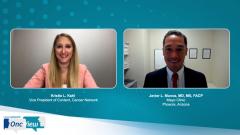
Treatment Options for Third Line R/R FL
Javier L. Munoz, MD, MS, FACP, describes the current third-line treatment options available for relapsed/refractory follicular lymphoma.
Kristie L. Kahl: Dr Munoz, what are the treatments available for third-line relapsed/refractory follicular lymphoma, and in particular, can you discuss the role of PI3 kinase inhibitors, and moreover, what the treatment goals for the third-line setting are?
Javier L. Munoz, MD, MS, FACP: Absolutely. If you go to the National Comprehensive Cancer Network guidelines for follicular lymphoma, you will find multiple options for third-line and subsequent therapy for this disease, including PI3 kinase inhibitors, including the EZH2 inhibitor that we have briefly mentioned, tazemetostat, and even going all the way to finding CAR [chimeric antigen receptor] T-cell therapy, axicabtagene ciloleucel, as an option for these patients. When it comes to PI3 kinase inhibitors, you have copanlisib, duvelisib, and idelalisib for patients who are facing relapsed/refractory follicular lymphoma after 2 prior therapies. Also we have nowadays umbralisib for patients who have relapsed/refractory follicular lymphoma after 3 prior lines of therapy. The wording for the EZH2 inhibitor tazemetostat is as follows: if you have an EZH2 mutation and you have relapsed or refractory disease after 2 prior therapies, you’re a candidate for this particular medication; also if you have EZH2 wild type or unknown status relapsed/refractory disease in patients who do not have satisfactory alternative options. So bottom line, when it comes to tazemetostat, this EZH2 inhibitor, you have a potential pathway to use this medication whether or not the EZH2 mutation is present.
I also mentioned the possibility of axicabtagene ciloleucel, or the anti-CD19 CAR T-cell therapy, which is FDA approved only for patients who have received 2 or more lines of systemic therapy with follicular lymphoma. Of course, it has other indications, but I’m going to try to zero in on follicular lymphoma at this point. You were asking me about our goals of therapy, and again, one size does not fit all. The goals for these patients may not be the same. CAR T cells would be a very complex process that, again, may not be for every patient because, similar to transplant, you need a very reliable caregiver. You need to live very close to a facility, or stay in proximity to a facility that prescribes CAR T cells, for safety. We want to make sure that we monitor toxicity during or post CAR T cells. And because of that, the goals for patients who choose PI3 kinase inhibitors or an EZH2 inhibitor may not be the same as patients who go all the way to consider transplant as a therapeutic maneuver or CAR T cells as one of the options when it comes to their journey in this disease.
Transcript edited for clarity.
Newsletter
Stay up to date on recent advances in the multidisciplinary approach to cancer.






